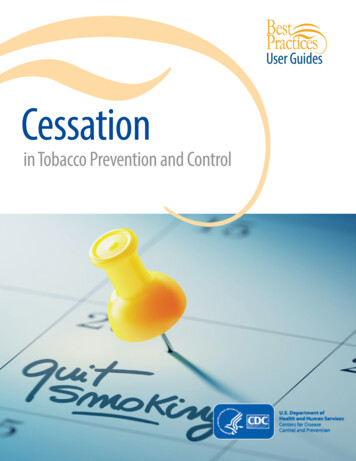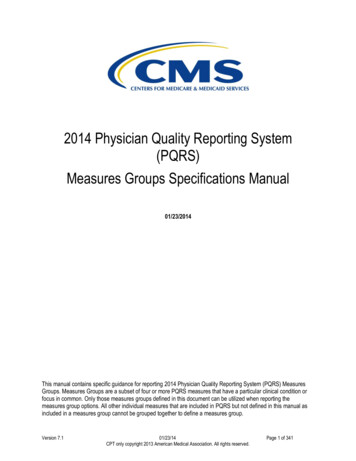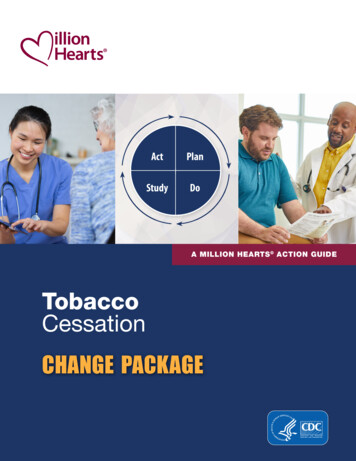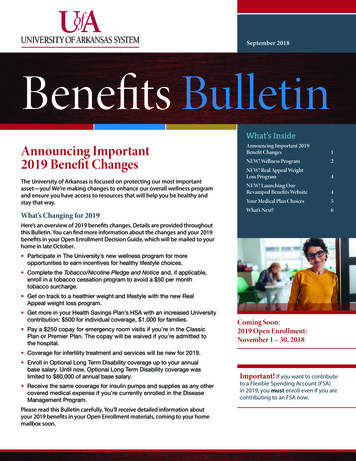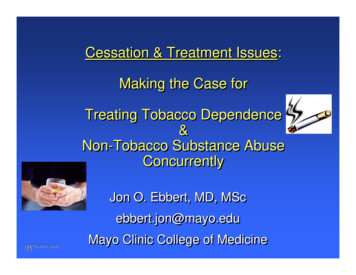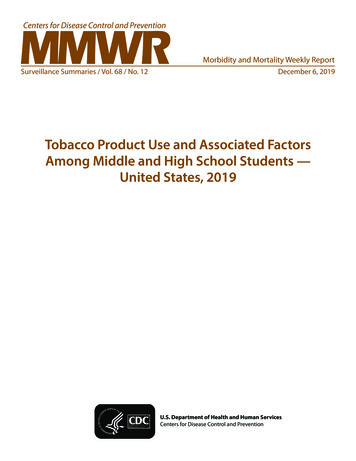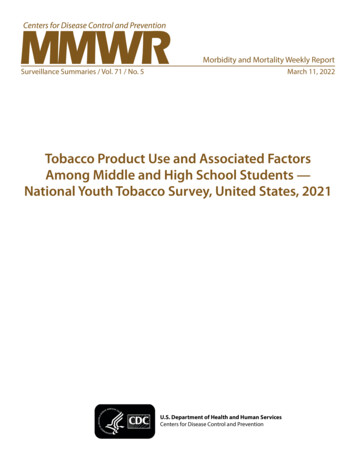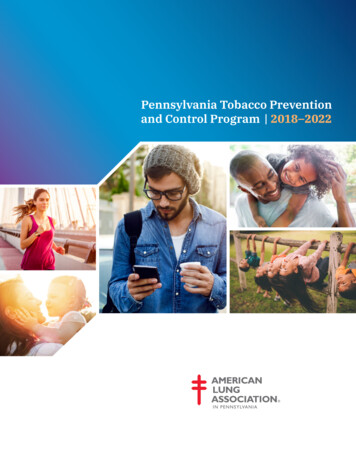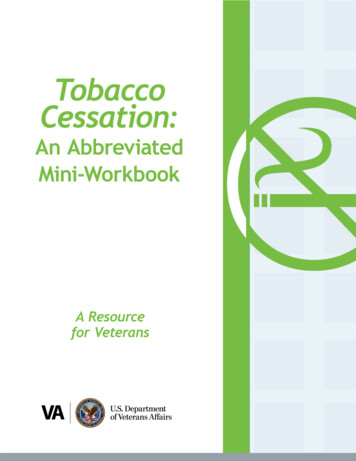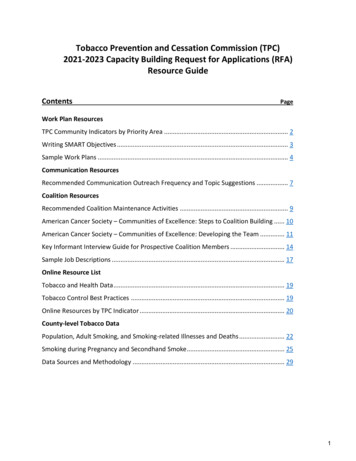
Transcription
Tobacco Prevention and Cessation Commission (TPC)2021-2023 Capacity Building Request for Applications (RFA)Resource GuideContentsPageWork Plan ResourcesTPC Community Indicators by Priority Area . 2Writing SMART Objectives . 3Sample Work Plans . 4Communication ResourcesRecommended Communication Outreach Frequency and Topic Suggestions . 7Coalition ResourcesRecommended Coalition Maintenance Activities . 9American Cancer Society – Communities of Excellence: Steps to Coalition Building . 10American Cancer Society – Communities of Excellence: Developing the Team . 11Key Informant Interview Guide for Prospective Coalition Members . 14Sample Job Descriptions . 17Online Resource ListTobacco and Health Data . 19Tobacco Control Best Practices . 19Online Resources by TPC Indicator . 20County-level Tobacco DataPopulation, Adult Smoking, and Smoking-related Illnesses and Deaths . 22Smoking during Pregnancy and Secondhand Smoke. 25Data Sources and Methodology . 291
Community Indicators2021-2023 TPC Capacity-Building GrantsPriority Area: Decrease youth and young adult tobacco use ratesYouth Empowerment/VOICE (2)optionalExtent of community activism among youth to support communitychange that includes youth involved in the VOICE movementPoint-of-sale (3)Extent of broad-based community support for commercial tobaccoPoint-of-Sale (POS) strategies at the local levelPriority Area: Increase proportion of Hoosiers not exposed to secondhand smokeTobacco-Free Schools (7)Proportion of school districts with comprehensive tobacco-freecampusesMulti-Unit Housing (8)Proportion of comprehensive smoke-free policies in multi-unithousingPriority Area: Decrease adult smoking ratesQuitline (11)Extent of utilization of the Indiana Tobacco Quitline (ITQL)throughout the communityPriority Area: Protect and maintain a state and local infrastructure necessary to lower commercial tobacco use ratesCoalition (14)Extent of intersectional partnerships within the broad-basedcoalitionMarginalized Populations (15)Extent of participation by groups serving marginalized populations inthe community2
Writing SMART ObjectivesSMART OBJECTIVES are statements that describe the results to be achieved and how they will be achieved.Developing SMART Work Plans Specific Measurable Achievable Relevant Time-boundSpecific-identifies a specific event or action that takes place What is expected to change?Where will change occur?Measurable-quantifies the amount of change to be achieved How much change?How does the change compare to baseline?Achievable-is realistic given available resources and plans for implementation With a reasonable amount of effort and application, can the objective be achieved? Are you attemptingtoo much?Relevant-is logical and relates to program and goals Is the objective important or worthwhile to the stakeholders?When in doubt, refer to the TPC Priority areas, Community Indicators, and contract deliverables (andCDC’s Best Practices)!Time-bound-specifies a time by which it will be achieved When will change occur? Is there a time limit? When will this objective be accomplished?SAMPLES:Electronically embed the Indiana Tobacco Quitline fax referral into EMR/EHR of one healthcare system in PrinceEdward County by June 30, 2022.Pass and implement a comprehensive smoke-free indoor air policy within two local market rate multi-unit housingcomplexes by June 30, 2022.3
Priority Area 1: Decrease Youth and Young Adult Tobacco Use RatesIndicator 2: Youth Empowerment/VOICEExpected Outcome:SMART Objective for Indicator:Buildand andsustaina coreleadershipteam of 5-10youth( supportyouthempowermentin JonesCountycreatinga CoreTeam ofat least5 members,building an Action Squad of up to 15 additional members, and completing 8 days of action by June 30,2023.DeliverablesComplete a recruitment plan for VOICE Core Team andAction Squad.Describe vision to meet deliverables for 2021-2023The coordinator will work with the Youth Coordiantor and TPC Director of Youth Programs to educatecoalition members on VOICE and a youth empowerment model (July 2021)The coordinator, Boys and Girls Club, and lead agency will ensure youth coordinator is trained on VoiceDUE: SEPTEMBER 30, 2021model (July-Aug 2021)Establish a VOICE Core Leadership Team and submit online The youth coordinator will develop a list of potential local groups and a key contact for youth engagement(Aug 2021)intake and roster forms.- Minimum of 5 and maximum of 10 youth allowed in core The youth coordinator will assess the level of engagement and commitment among youth who areinvolved in the Core Team and Action Squad (August 2021) and recruit youth committed to Core Team.team(Sept. 30, 2021)- Must be 13-18 years oldThe youth coordinator will work with TPC Director of Youth Programs and core team to plan youth training(July 2021)DUE: DECEMBER 31, 2021The youth coordinator and core team will hold a capacity building training for newly engaged youth andExecute 2 National Day of Action Activities in partnershiporganizations. (Sept. 2021)with VOICE Core Leadership TeamThe Core Team will draft plans for each Day of Action, including activity, giveaway items, and goals.Youth Coordinator will provide youth empowerment activity calendar to Core Team and Action Squad andDUE: (See VOICE Calendar document)work to gain participation from all VOICE Youth in each opportunity.March-Taking Down Tobacco NDOAYouth Coordinator will participate in all adult ally trainings.May- World No Tobacco DayYouth Coordinator will assess commitment and level of engagement among core leadership teammembers.Participate in ALL required VOICE statewide youthYouth Coordiantor and coalition members will provide an opportunity for 1-2 youth on the core team toempowerment meet ups and capacity buildingjoin the state leadership team and support them with the application process.opportunities:The Core team will organize, promote, and support monthly core team and action squad meetings- 4 Regional Action Squad and Core Team Meet Upsaccording to the calendar approved by the core team.- 3 Statewide Core Team TrainingsYouth Coordinator will participate in UpRISE training and implement program with youth.- 3 Adult Ally Trainings/webinarsYouth Coordinator and coalition members will recruit youth to participate with VOICE Alumni Network andsupport youth membership and participation in the Alumni Network.DUE: See VOICE Calendar DocumentProvide a letter of recommendation for at least one youthfrom your core team to serve on the statewide youthleadership team for VOICE Youth Ambassador ProgramDUE: DECEMBER 31, 2022Hold monthly core team/action squad meetings that honorand adhere to the youth empowerment model and positiveyouth development best practices.DUE: MONTHLYImplement the UpRISE Social Justice Youth TobaccoControl Curriculum and execute required modules withcore youth for VOICE programming and project planningfor all National Day of Action Activities.DUE: QUARTERLYSupport the transition of Core Team leaders into the VOICEAlumni Network (young adult programing).DUE: ANNUALY4
Priority Area 1: Decrease Youth and Young Adult Tobacco Use RatesIndicator 3: Point-of-SaleExpected Outcome:SMART Objective for Indicator:Educate the community on commercial tobacco Point-of-Sale advertisingConduct at least eight presentations on point-of-sale advertising to youth and adult audiences,incorporating data from STARS survey based on availability, by June 30, 2023.DeliverablesParticipate in Standardized Tobacco Assessment of RetailSettings (STARS) biennial survey to collect county-leveldata on commercial tobacco products and point-of-saleadvertising in retail establishments.Describe vision to meet deliverables for 2021-2023We will review the resources provided on point-of-sale, including Counter Tobacco and TobaccoFree Kids, within the first two months of the grant award. Our September coalition meeting will bedevoted to educating the local coalition on point-of-sale strategies, drawing from the informationprovided in resources mentioned above, in addition to guidance and resources provided by TPC. Thecoalition will assess our collective sphere of influence on youth, youth-serving organizations,partners, and other stakeholders to identify appropriate audiences for adult-and youth-focusedDUE: MARCH 31, 2022presentations on how tobacco products are priced and marketed to teens. Presentations will beConduct youth and adult-focused presentations on howcommercial tobacco products are priced and marketed to delivered by coalition coordinator or coalition members, and one will be scheduled approximatelytarget teens. Include information about flavored tobacco every quarter in the grant cycle. Coalition coordinator, coalition members, and volunteers willproducts including menthol and their impact on youth and participate in STARS annual survey (February-April of 2022) to collect county-level data on tobaccoproducts and point-of-sale advertising in retail establishments. Data will be incorporated intoour most marginalized communities. Appropriatepresentations on point-of-sale as it becomes available.audiences may include youth ages 12-18 years, youthserving organizations, internal and external partnersincluding coalition members and lead agencies, and keydecision makers in the community.DUE: QUARTERLYProvide education to the coalition regarding commercialtobacco related Point-of-Sale strategies.DUE: DECEMBER 31, 2021; JUNE 30, 2022; DECEMBER 31,2022; JUNE 30, 2023Conduct Community Conversation with a panel ofstakeholders and subject matter experts representative ofthe community. Include results of local tobacco retailersassessments from STARS biennial survey. Includeinformation about flavored tobacco products includingmenthol and their impact on youth and our mostmarginalized communities.DUE: DECEMBER 31, 20225
Priority Area 3: Reduce Adult SmokingIndicator 11: QuitlineExpected Outcome:Build a network of healthcare providers and organizations that routinely refer tobacco users to theIndiana Tobacco QuitlineSMART Objective for Indicator:Recruit and enroll 15 new healthcare providers to the Quit Now Indiana Preferred Network andincrease Francisco County direct referrals (fax, online, electronic) to the Indiana Tobacco Quitline byaveraging 15 referrals/month by June 30, 2023.DeliverablesConduct outreach with healthcare providers (such as hospital systems, primary care providers,pediatric offices, outpatient centers, dentists, and pharmacists) to promote the Indiana TobaccoQuitline and to develop relationships- Outreach with all new contacts on the Quit Now Indiana Preferred Provider Network list todetermine interest level and intensity of follow up needed- Intense outreach to Quit Now Indiana Preferred Provider Network members with a high interestlevel through ongoing follow-up (by phone, email, or in person)- Track outreach to Quit Now Indiana Preferred Provider Network and Quitline referrals andacceptance rates from providers contacted- Connect healthcare representatives interested in electronic referral to the Indiana TobaccoQuitline with TPC cessation staffDescribe vision to meet deliverables for 2021-2023We plan to evaluate our county and existing partnerships to create a database of all the healthcaresystems (hospitals, clinics, etc.) in our community within the first 3 months of the grant. This willbegin with reviewing the current Quit Now Indiana Preferred Network to see if any providers orhealthcare systems are already enrolled as a preferred member. Based on our review, we will targethealthcare systems that we have an existing partnership with first. A few existing partnershipsinclude Healing All Hospital, Francisco County Community Health Center and Frankville OutpatientHealth Clinic. In conducting this outreach, we will connect with leadership of the healthcaresystem(s) (or other key contacts within the health system) to discuss their current strategies foraddressing/treating a tobacco user in their respective setting. We will also work to determinewhether or not they are familiar with the Indiana Tobacco Quitline and the Quit Now IndianaPreferred Network. If they are not familiar, we will strategize with key stakeholders on a plan totreat tobacco users in their setting. This includes enrolling them as a preferred provider, employeror organization and educating them on the importance of identifying a tobacco user, interveningDUE: MONTHLYwith the tobacco user and connecting the tobacco user with evidence-based support such as theConduct ongoing outreach with health care providers that serve marginalized populations (such as Quitline. We will also train on the Indiana Tobacco Quitline and appropriate methods of referral toCommunity Health Clinics, Federally Qualified Heath Centers, mental health centers, opioidthe Quitline (fax, online, electronic). If we are able to identify a champion within the healthcaretreatment/addiction providers, and recovery centers) to promote the Indiana Tobacco Quitlinesystem, we will work to recruit him/her to the coalition and any other tobacco control efforts in theand to develop relationshipscounty. In developing our plan with the healthcare system, we will determine a training plan for the- Outreach with all new contacts on the Quit Now Indiana Preferred Provider Network list toproviders and/or departments of the system. The training plan will include an outline ofdetermine interest level and intensity of follow up neededrecommended in-person training opportunities, training content and ongoing support that can be- Intense outreach to Quit Now Indiana Preferred Provider Network members with a high interest provided following the trainings.level through ongoing follow-up (by phone, email, or in person)- Track outreach to Quit Now Indiana Preferred Provider Network and Quitline referrals fromWhile our existing partnerships will be our primary target, we will also work to identify newproviders contactedpartnerships to continue building our coalition and expanding the reach of the Quitline. Some newpartnerships could be formed with Frankville Mental Health Center, Healthier Minute Clinic and theFrankville Pharmacy. Our outreach will be ongoing so we plan to document our activities on a TPCprovided tracking form or create our own tracking log. Lastly, we will continue to provide follow-upto our Quit Now Preferred Network members on their activity regarding direct referrals to theConduct ongoing outreach with organizations that serve marginalized populations (such asorganizations serving pregnant women, Lesbian, Gay, Bisexual, and Transgender (LGBTQ ) people, Quitline as well as addressing any challenges/barriers they have concerning the Quitline.veterans and members of the military, Medicaid members, uninsured residents, people with lowincome and low education, people experiencing homelessness or domestic violence, people withdisabilities, and vocational training programs and faith-based organizations)- Outreach with all new contacts on the Quit Now Indiana Preferred Organization Network list todetermine interest level and intensity of follow up needed- Intense outreach to Quit Now Indiana Preferred Provider Network members with a high interestlevel through on-going follow-up (by phone or in person)- Track outreach to Quit Now Indiana Preferred Provider Network and Quitline referrals fromorganizations contactedDUE: MONTHLYDUE: MONTHLY6
Recommended Communication Outreach Frequency and Topic SuggestionsRecommended Communication Outreach Frequency: Letter to the editor (LTE) submissions: At least once per month (refer below to recommendedtopics and timing)o TPC provides at least one LTE sample per month for partners to distributeSocial media postings: At least once per week, per registered social media channel (Facebook,Twitter, Instagram)o TPC provides social media topics and some draft postingsGuest article in local/business/company newsletter (online or print), blog, newspaper: At least 2times per yearo Reach out to coalition member networks and see what local media distributions existo TPC can assist with brainstorming and drafting guest articles submissionsYouth Empowerment/VOICE and Point of Sale Indicators: Topicso General point of sale/retail environmento Youth targeting (price, flavor, marketing)o Other tobacco products (chew/spit tobacco, e-cigarettes, hookah, little cigars, etc.)Ideal LTE distribution times (2 LTEs per year)o Back to school season (end of July to September)o Halloween (flavored products)Social media accounts to follow:o Counter Tobacco, Counter Tools, Voice, Campaign for Tobacco Free Kids, Truth Initiative, FDAThe Real Cost, Truth, Fresh Empire, American Academy of PediatricsTobacco-free Schools TopicsoooImportance of comprehensive tobacco-free campuses, including e-cigarettesBest practices for schools for how to address timely issues, such as e-cigarette and JUUL usageVape Free Indiana – additional resources for parents, teachers, and healthcare providersMulti-Unit Housing Indicator: TopicsooBenefits of smoke-free MUH (resident health, economical for property owners)Legality of smoke-free MUHAt least 1 LTE per yearSocial media accounts to follow:o Smoke-Free Housing Indiana, Americans for Nonsmokers Rights7
Recommended Communication Outreach Frequency and Topic SuggestionsQuitline Indicator: TopicsooCessationHealth observances (i.e. American Heart Month, Lung Cancer Awareness Month, Great AmericanSmokeout)o “Talk to your doctor”o Quitline services (Phone counseling, Web Coach, eQuit, Text2Quit, Individual Services)Ideal LTE distributiono During health observances (TPC sends notifications on upcoming observances)o At least 3 LTEs per yearSocial media accounts to followo CDC Tobacco Free, America Lung Association, American Heart Association, American CancerSociety, American Medical Association8
Recommended Coalition Maintenance Activities Develop leadership structure and decision-making processes (bylaws) within the coalition.Schedule meetings at a regular time and place each month.Send coalition meeting notices and reminders in advance of the meeting each month.Share coalition meeting details (location, time) on coalition social media channels. CreateFacebook events for upcoming coalition meetings.Prepare agendas and record minutes for each coalition meeting. Share minutes with memberswithin one week of meeting.Ensure each meeting results in action items for coalition members to complete.Provide training to the coalition on topics relevant to the workplan and evidence-based tobaccocontrol practices. (Reference CDC Best Practices.) This can include sharing news items, factsheets, or other relevant pieces at each meeting that help educate the coalition on variousaspects of tobacco control.Share the workplan with the coalition, discuss progress, and ask for their input and assistance ondeliverables that interest them.Survey any new members to determine interests, skills and possible networks for outreach.Develop a coalition brochure or other coalition recruitment tool for prospective coalitionmembers and partners.Develop a coalition newsletter and distribute among appropriate communication channels.Newsletters can include recent coalition activity, current events in tobacco control, goals for theyear, guest article submissions, coalition member highlights, etc.Recommended ResourcesCoalition Roles and Job uploads/coalition roles and job descriptions.pdfCoalition s/Coalition-Bylaw-Contents.pdfCoalition Meeting ds/coalition meeting checkup.pdfCoalition Member s/coalition member survey.pdf9
Steps to Coalition Building & Developing the TeamSteps to Coalition Building1. Identify the core group of tobacco control champions in your community. These are thepeople who are known to be passionate and committed to tobacco control and put aside theirown agendas for the greater good.2. Including non-traditional partners will help make your planning effort more representative aswell as enlarge your base of support. Non-traditional partners will vary with each communityand may include: youth, seniors, business leaders, people from different neighborhoods andpopulation groups, and religious leaders.3. Ask each person/group what they think they can bring to the effort – that is, what skill,perspectives, and resources they have to contribute. Learn how they want to be involved andhow they will not/cannot be involved (e.g., some people cannot be part of any policy work).4. Develop leadership structure and decision-making processes (bylaws) within the coalition.10
Steps to Coalition Building & Developing the TeamIncreasing the Diversity of Your Tobacco Control TeamWho else will help to make your planning efforts more representative of your community?Consider including people and organizations that you may not usually include in your planningefforts and programs. Including others will help to enlarge your base of support and bringadditional resources to your tobacco control efforts. Use this chart to help you identifyadditional people and organizations and what each has to offer to your community’s tobaccocontrol efforts.Person’s Name andOrganizationWhat they have to offer to thetobacco control effortsYouth-led groupsYouth Advocacy Organizations(ie: PTOs, PTAs, Boys Clubs,Girls Clubs)Ethnic Specific CommunityGroupsSeniorsBusiness leadersReligious leadersEnvironmental groupsDrug prevention organizationsSurvivor support groups11
Steps to Coalition Building & Developing the TeamPerson’s Name andOrganizationWhat they have to offer to thetobacco control effortsLabor/employee unionsRestaurant ownersNeighborhood associationsHospitals that serve the areaLocal health departmentsCounty nursing servicesLocal medical associationsLocal dental associationsOther health care professionalsLaw enforcementSchools, including colleges anduniversitiesMedia12
Steps to Coalition Building & Developing the TeamPerson’s Name andOrganizationWhat they have to offer to thetobacco control effortsParent groupsFormer tobacco usersOthers13
Key Informant Interview GuideProspective Coalition MemberPurpose of the Interview:Engage prospective coalition members in the community to come together and work on acomprehensive tobacco control effort.Process for Setting up Interviews:Contact the potential interviewee and request a one-hour meeting to complete the interview.At the time the interview is being scheduled, provide the interviewee with the followinginformation: Name and explanation of your organizationDescribe your partnership with TPCExplain that the interviewee is seen as a prospective coalition member in thecommunity and you believe they can provide valuable information related tocomprehensive tobacco control.Tell the interviewee that the interview will take approximately 45 minutesExplain that specific answers will not be attributed to interviewees so they arecomfortable that the information they share will be confidentialAsk if they have any questions at this timePreparing for the Interview: Bring state and local data on smoking Bring copies of basic fact sheets on burden of tobacco use Bring a coalition information page that includes: Contact Information Meeting Schedule Coalition goals / strategic plan14
Key Informant Interview GuideProspective Coalition MemberWhat sector of the community does the prospective coalition member represent?(ie. faith-based, school, business, medical)Name of Interviewee:Position/Title:Date Interviewed:Interviewer:I represent and we work with Indiana TobaccoPrevention and Cessation (TPC) on tobacco control issues in our community. As I explained onthe phone, we think that this is an excellent opportunity for us to gain a better understandingof your thoughts and ideas related to tobacco use prevention and cessation in our community.As a key public health leader, we value your input. We greatly appreciate you taking the timeto meet with us.[As you may know, smoking in our state/community is a critical problem (provide data). We areworking to do everything we can to help Hoosiers quit smoking.]1. What do you know about tobacco use in our community? (ie. smoking rates, localordinances, school policies)2. How does tobacco use in the community impact you and your organization?15
Key Informant Interview GuideProspective Coalition Member3. What are your personal experiences with tobacco or tobacco control?4. What community events have you heard about or participated in that were sponsoredby our tobacco control coalition?5. What are some ways our local tobacco control coalition could assist you and yourorganization?6. Are you interested in partnering with our coalition? What are you willing to do? Isthere anything you are unable to do? (ie. legal restrictions)7. Do you know anyone else who might be interested in participating in the coalition?8. Other comments or suggestions?Thank you for taking time for this interview. If you have additional questions or concerns, I canbe reached at16
Sample Job DescriptionsTPC Local Youth Coordinator (VOICE Adult Ally):Will be responsible for working per week in the community, available to travel in-county and toother locations in the state several times per year for statewide training and meetings (See VOICECalendar).Will be responsible for overseeing the execution of activities for Priority Area 1 (Decrease Youth andYoung Adult Tobacco Use Rates) and required deliverables for the following Indicators:1. Middle and High School Prevention2. Youth Empowerment/VOICE3. Point-of-SaleResponsibilities Managing and convening County-wide VOICE Core Leadership Team Youth coordinator will submit periodic electronic reports as required and respond to local andstate needs for information as directed by the TPC Youth Program Director. Youth coordinator will be responsible for recruiting public schools selected to conduct the YouthTobacco Survey in Fall 2022. Youth coordinator will recruit and organize a diverse group of individuals and organizationalrepresentatives of youth related organizations from the community. The coordinator will support the coalition to strategize action to reduce youth commercialtobacco use in the county through policy and programs. Expand reach by participating in local/regional/state community events, conferences and/orfairs within assigned geographic areas to promote VOICE programs, campaigns/initiatives, andservices. Youth coordinator will commit to support youth engagement strategies and study CDC’s BestPractices model in commercial tobacco control. The Youth coordinator will use proven,evidence-based actions to reduce commercial tobacco use and exposure to secondhand smoke,and to prevent commercial tobacco use in the community. Youth coordinator will accept training and technical assistance and fully participate in the localand statewide youth empowerment program and initiatives.The ideal candidate should have: Leadership skills especially in the area of youth engagement Community organizing skills; experience recruiting and organizing volunteers Marketing and networking skills; experience with developing community relationships Familiarity with social media and online meeting platforms An understanding of public health principles and best practices The ability to work independently Excellent written and oral communication, including public speaking skills Passion for the youth empowerment model Passion for the pursuit of health equity for all17
Sample Job DescriptionsTPC Local Program Coordinator: Will be responsible for working per week in the community, available to travel in-county and toother locations in the state several times per year for training or meetings (see Lead Agency ProfileForm). Physical lifting may be required for materials or AV equipment. Coordinator will submit periodic electronic reports as required and respond to local and state needsfor information as directed. Coordinator will be responsible for recruiting public schools selected to conduct the Youth TobaccoSurvey Fall 2022. Media responsibilities include developing partnerships with local news venues and providingaccurate local, state, national and international information on tobacco control to the news mediaas is necessary for education of the public on tobacco issues. Coordinator will recruit and organize both individuals and organizational representatives from thecommunity to form a coalition representing diverse interests and backgrounds. The coordinator will lead the coalition to strategize action to reduce commercial tobacco use in thecounty through policy and programs. Coordinator will fully engage community and coalition members, including specific task forcegroups, in the business of commercial tobacco co
2021-2023 Capacity Building Request for Applications (RFA) Resource Guide . youth development best practices. DUE: MONTHLY Implement the UpRISE Social Justice Youth Tobacco Control Curriculum and execute required modules with core youth for VOICE programming and project planning for all National Day of Action Activities. DUE: QUARTERLY Support the transition of Core Team leaders into the .
